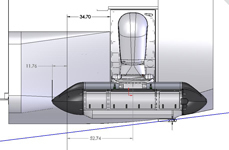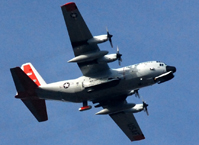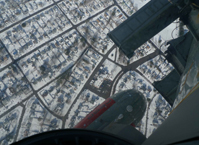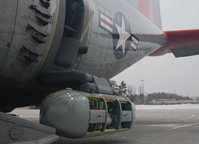| |
Home
Background
Science Plan
Pod Testing
Science Specifications
Science Instruments
From the Field
Antarctic Season
Education
Outreach
Project Personnel
Polar Geophysics Group
Lamont-Doherty Earth Observatory
EXTERNAL LINKS
NYANG 109th
|
|
Pod Science Specifications
The icepod is a modular data collection and aquisition system measuring 8.5 foot long by 2 foot wide with the interior divided into three bays ~ 2 foot inside. The cones that fit onto the ends provide additional space for instruments. PDF of specifications. |
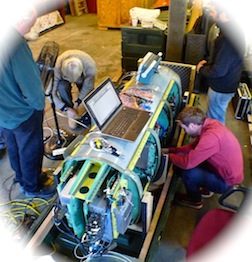
Outside |
Inside |
- Door Plug
- SABIR Arm
- Sensor Pod & Sensors
|
- Avionics Rack (Data Aquisition)
- Power Rack (UPS and power supply conditioning)
|
System Components: The pod is designed to be flown on a C-130 Hercules Aircraft without special modifications to the aircraft. Installation or removal can be done by in less than a day with its modular design allowing it to move to different C-130 aircraft if needed. The baseline configuration is set up for high-resolution, fine-scale temporal monitoring of ice-sheets, their margins and adjacent ocean processes. Other configurations may include atmospheric process monitoring, measurement of bathymetry in difficult to access locations, temperate climate processes, canopy definition and ‘Search and Rescue’ to name but a few. The system components include:
Platform Specification:
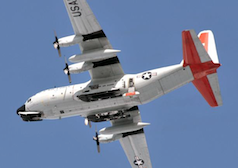 |
Hercules LC-130
Cruise Altitude: 20,000ft to 28,000ft MSL
Cruise Speed: 270 knots (true airspeed)
Survey Elevation with Icepod: Typically 3000 ft AGL +/- 3%
Survey Speed: Typically 170 knots (indicated ground speed)
Duration: Up to 10h
Track Reoccupation: Typically +/- 100m
|
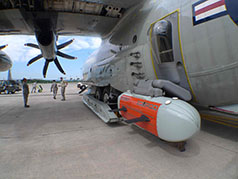 |
Icepod Door/Arm
Weight: Door Plug: 120lb
SABIR Arm: 350lb
Unladen weight of the pod= 154lb
Maximum allowed weight of the Icepod including sensors = 425lb [limitation is currently set by certification. Increase in allowable weight to 600lb expected in 2014].
|
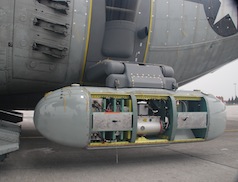 |
Icepod Volume
The Icepod includes:
Three bays with dimensions of 18” x 24” x 24”
Two Nose Cones with dimensions 20” high by 24” diameter
Vibration: Vibration isolation mounts available. Otherwise Mil Standard 810 G [Procedure details on request]
Temperature: Heat Dissipation via Cold-wall
Heating: Localized pad heaters available
Pressure: Unpressurised
Sensor Mounting Points: Sensors are mounted to brackets or vertical plates attached to the ‘StrongBack’ located in the roof of the pod and/or floor of the pod.
|
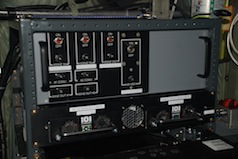
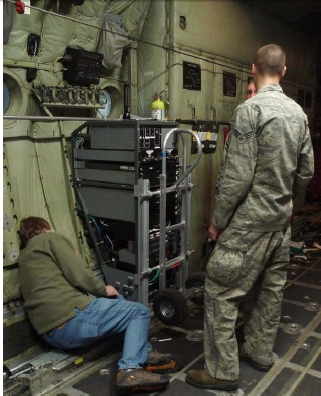
|
Power
Icepod system power is derived from the Aircraft Missile Support AC Bus and the Iron Lung DC Bus. It is isolated from the aircraft supply via a double conversion UPS with additional EMI Filtering. Hold-up time for the UPS is approximately 5 minutes on full load and is used to tolerate brownouts and power dropouts at ground/aircraft power handover.
From Aircraft Supply:
3 Phase, 115VAC, 400Hz from the Missile Support Bus to the Icepod UPS. Maximum power demand = 2800W. Typical operational power demand = 900W.
115VAC, 400Hz Phase A from the Missile Support Bus to the Icepod SABIR Arm Drive system. Max operating power = 250W.
+28Vdc from the Iron Lung Bus to the Icepod UPS. Max power demand = 1000W. Typical operational power demand = 400W.
+28Vdc from the Iron Lung Bus to the Icepod dc Heater system. Max operating power = 700W.
UPS Output 1: Single Phase 60Hz 115Vac to the Icepod Avionics rack
UPS Output 2: +28Vdc to the Icepod sensors
Icepod Sensor Power Supplies:
+28Vdc, 1KW
+/-15Vdc, 100W
+5Vdc, 50W
Others on request.
(Image of Avionics Rack being installed) |
Sensor Specification:
All sensor specifications, unless otherwise stated, are given for flying at the survey elevation of 3000ft AGL and survey speed of 170 knots (indicated ground-speed).
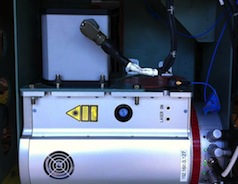 |
a. Lidar (Click image for data sample)
Line scanner providing fully linear, unidirectional and parallel scan lines.
Data Products: Geo-referenced point-cloud incorporating Range, Reflectivity, Amplitude.
Spot Size on the ground: 20 cm (at 3000 ft AGL)
Range accuracy: 25 mm
Point Density: 1.2 pixels/square meter
Swath width: 1154m (at 1000m AGL & 60° FOV).
Power Supply: +18 to 32Vdc, 65W
Weight: 13 kg
Calibration: Coefficients defined on install into pod prior to shipping
|
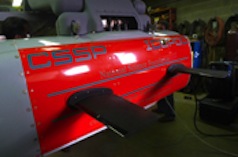 |
b. Depth Sounding Radar
Pulsed chirp depth sounding radar providing ice depth, sub-surface water distribution, internal structure.
Data Products: Geo-referenced compressed radar-grams, bed picks.
Power Output: > 1200 W
Center Frequency: 188 MHz
Bandwidth: 60 MHz
Chirp Length: 1 uS, 10uS
Depth Resolution: < 2 meters
Along-track Resolution: 0.6 meters (No external stacking)
Maximum Depth Penetration: > 3.5 km Northern Hemisphere (Cold Ice)
>5 km Southern Hemisphere (Cold ice)
Power Supply: +18 to 32Vdc, 120W
Weight: 100lb
Calibration: Antenna beam pattern measured in-situ on pod. Transmit power (before antennas) measured at installation into pod prior to shipping. |
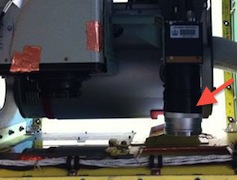 |
c. Visible Wave Camera
(Click image for data sample)
High-resolution visible wave color camera providing high quality imagery for photogrammetry and feature recognition.
Data Products: Geo-referenced images
Part Number: IMPERX Bobcat IGV-B6620C-KFO
Image Size: 6600 pixels by 4400 pixels or 29M Pixels
Lens: Typically Zeiss Distagon T, f/2, 50mm
Point size on the ground: 20cm
Point Density: 25 pixels/square meter
Swath width: 1.2km
Frame rate: 1 fps
Image Overlap: 90%
Power Supply: +10 to 15Vdc, 18W max
Weight [body & lens]: 2lb
|
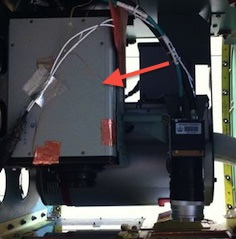 |
d. Thermal Infra-Red Camera (Click images for data sample)
High Performance thermal Infra-red, closed cycle Sterling Engine cooled camera providing high quality thermal imagery.
Data Products: Geo-referenced surface thermal structure with <20mK NEDT and high dynamic range
Part Number: Sofradir IRE640L
Spectral Band: 7.7 – 9.5um
Dynamic Range: 14-bit
Image Size: 640 pixels by 512 pixels or 0.33M Pixels
Lens: 50mm equivalent Germanium
Point size on the ground: 78cm
Point Density: 1.28 pixels/square meter
Swath width: 400m
Frame rate: >100 fps
Image Overlap: 60%
Uniformity Correction: Four on-board selectable tables
Power Supply: +10 to 15Vdc, 18W max
Weight [body & lens]: 9lb |
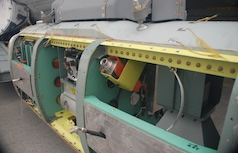 |
e. Infrared Radiation Pyrometer (Click image for data sample)
The Pyrometer records sky temperature which is subtracted from the IR Camera data in post-processing to give absolute temperature of thermal imagery.
Data Products: Timestamped 1Hz measurement of sky temperature
Part Number: Heitronics KT15-IIP
Temperature Range: -100C to +200C
Spectral Band: Narrowband 9.6um to 11.5um
Temperature Resolution: 0.65 C
Image Size: Single Point
Sample rate: 1 Hz
Response Time: 1 s
Power Supply: +22 to 30Vdc, 4W max
Weight [body & lens]: 1.1lb |
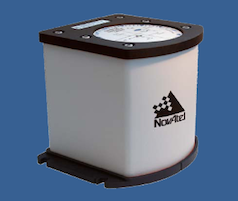 |
f. GNSS
High resolution platform position and orientation. The GNSS system consists of a Novatel Span SE L1/L2 GPS Receiver and Litton based LN200 IMU mounted within the Pod. The IMU is hard mounted to the LIDAR inside the Optics bay. A Leica GNSS Receiver mounted in the Avionics rack inside the aircraft records data from a GNSS Antenna mounted on the cockpit emergency escape hatch.
Data Products: Aircraft Position < 10cm, Pitch, Roll, Yaw
Part Number: Novatel SPAN SE, Litton LN200
Spectral Band: L1/L2
Sample Rate: 10Hz
Power Supply: +22 to 30Vdc, 20W max
Weight [GNSS & IMU]: 7lb |
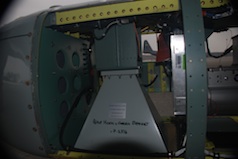 |
g. Shallow Ice Sounding Radar (Click image for data sample)
High Frequency FMCW radar that can record near-surface processes, Firn depth, Snow-pack depth, Sea-ice depth.
Data Products: Geo-referenced compressed radargrams.
Power Output: < 1 W
Center Frequency: 2 GHz
Bandwidth: 600 MHz
Chirp Length: 1 ms
Depth Resolution: 0.25 meters
Along-track Resolution: Nominally 4 meters
Maximum Depth Penetration: Approximately 350 meters
Power Supply: +18 to 32Vdc, 50W
Weight: 20 lb
Calibration: Antenna beam pattern measured in-situ on pod. Transmit power measured at installation into pod prior to shipping. |
Additional/Future Sensors:
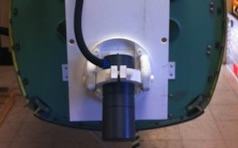 |
a. Magnetometer
A Cesium-3 Total Field Magnetometer will be deployed and tested with the Icepod during the spring of 2014.
Scintrex CS-3 cesium vapor magnetometer/Billingsley TFM100G2 magnetometer.
Data products Magnetic anomaly (nT)
Precision 0.1 nT
Sample rate 100 Hz
Weight 1.8 kg |
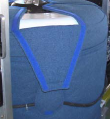 |
b. Gravimeter
A rack-mounted BGM-3 type Gravimeter will be tested with the Icepod system in the fall of 2014.
BGM3/L&R S-80
Data products Free air gravity anomaly (mGal)/Bouguer gravity anomaly (with lidar/radar)
Accuracy ~2 mGal
Along-track resolution 14 km (assuming 170 s filter)
Sample rate 1 Hz |
 |
c. CTD Sounders
An AXCTD deployment system integrated into the Icepod Door Plug will be tested in the summer of 2014. One of its uses will be to measure conductivity, temperature and depth profiles close to the calving fronts of marine terminating glaciers. |
| |
d. Atmospheric Sensors
A carbon dioxide sensor will be integrated into the nose cone of the pod in the summer of 2014 to test quality of airflow below the aircraft. |
Data Acquisition System Specification:
General
The Data Acquisition System consists of rugged, data acquisition computers, one for each sensor and a Master Controller or User Interface computer. The sensor computer OS can be either Linux or Windows allowing for specific manufacturer requirements. Configuration commands and data are passed between sensor computer and sensor via GigEthernet and can be converted to USB or Serial commands locally inside the pod if required. The Master Controller connects to each sensor computer via a network switch passing on User commands and taking, formatting and displaying real-time sensor data. The sensor data is time-stamped during data collection and is stored on removable solid-state hard-drives which can be removed at the end of a flight for archiving and post-processing purposes.
Display
The display shows real-time sensor current data file name, file size, instrument status, and processed images where possible converted on-the-fly from the sample data.
Special to type software
We can also write data acquisition software for clients, or co-code with clients, or integrate client software.
.
|
|
 |
